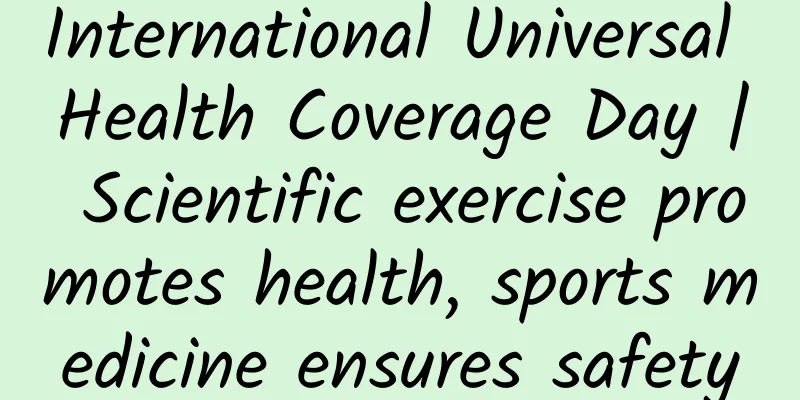International Universal Health Coverage Day | Scientific exercise promotes health, sports medicine ensures safety

|
Scientific exercise promotes health and has become a new trend in disease prevention and treatment It has become a consensus that scientific exercise promotes physical health and achieves the purpose of disease prevention and treatment. "Exercise" has been clinically applied as the troika for diabetes prevention and treatment. The preventive and curative effects of exercise are mainly reflected in the following major systems, including cardiovascular, respiratory, metabolic and endocrine, nervous, immune and tumor, digestive, musculoskeletal and motor systems, and typical diseases such as hypertension, hyperlipidemia, obesity, diabetes, stroke, tumor, Parkinson's disease, depression, musculoskeletal and joint diseases, and sarcopenia in the elderly. A study published in JAMA Network Open showed that smokers have a 41% higher risk of death than non-smokers, and the risk of cardiovascular death in patients with the lowest aerobic capacity can be as high as 4 times or more; the impact of exercise on health is far more intense than the impact of smoking on health. The threshold for effective exercise is not high. A study published by e-Life showed that short-term exercise can enhance brain function, and increasing 1 hour of light physical activity per day can reduce the risk of cardiovascular events by 10%. Even if the level of physical activity is lower than the recommended amount in the guidelines (150 minutes of moderate to vigorous physical activity per week), it can still significantly reduce the risk of coronary heart disease compared with almost complete inactivity. The National Cancer Institute of the United States has for the first time compared the effect of exercise participation on the risk of death in individuals of different ages, and found that it is never too late to start exercising. Specifically, even if you do not like to exercise in adolescence, the risk of all-cause death can still be reduced by 32% to 35% after increasing the frequency of exercise after middle age; even if you start to strengthen exercise in middle-aged and elderly stages, the mortality rates related to cardiovascular disease and cancer can be reduced by 43% and 16% respectively. Research published in Nature Reviews Immunology shows that exercise can improve immunity and delay aging, and can be used as a treatment method in clinical practice. Exercise should follow the principle of gradual progress, warm up before exercise, and pay close attention to your physical condition during exercise. Excessive exercise often does not pay off. When you experience symptoms such as dizziness, difficulty breathing, muscle pain, and mental fatigue after exercise, you need to reduce the total amount of exercise. A study published by Harvard University showed that the ability to do push-ups can reflect the health of the heart and can be used as a simple indicator to assess physical activity ability, making it easier to understand your own exercise and health level. Choose exercise methods reasonably and build new elements to promote health (1) Exercises to enhance physical fitness and strengthen the body: aerobic exercise, such as brisk walking, jogging, cycling, swimming, dancing, mountain climbing, etc.; ball sports, such as football, basketball, volleyball, table tennis, badminton, tennis, etc.; traditional Chinese sports, such as martial arts, Tai Chi, Mulan boxing, and Qigong; (2) Improve cardiopulmonary function: aerobic exercise, ball games (same as above); (3) Burn fat and reduce weight: Long-term aerobic exercise: brisk walking, jogging, cycling, swimming, dancing, mountain climbing, etc., with each exercise lasting 45 to 60 minutes; (4) Adjusting mental state: ball games, traditional Chinese sports (same as above); (5) Increase muscle strength: various strength exercises: dynamic/static freehand strength exercises against one's own body weight, strength exercises with dumbbells, kettlebells, elastic bands, yoga balls, barbells, etc.; (6) Improve flexibility: various stretching exercises; (7) Improve balance ability: traditional Chinese sports, ball games, strength training (same as above); (8) Improve reaction ability: various ball sports (same as above). Choose sports scientifically and follow the three principles of sports characteristics Age principle: In general, people's functions and quality levels begin to decline around the age of 40. Therefore, when choosing sports, young people can choose relatively intense and active sports; as they age, they should pay attention to safety and choose relatively mild sports, such as aerobic exercise, ball games, and traditional Chinese sports, which have the effect of enhancing physical fitness and strengthening the body. Different age groups can have different choices. Personalization principle: Every sport has its advantages and disadvantages, so it is not enough to rely on just one type of exercise. For example, brisk walking and jogging can enhance cardiopulmonary function and are also suitable for burning fat and losing weight, but they are not satisfactory for improving body flexibility; strength training can effectively stimulate muscle tissue and increase muscle strength, but has less impact on the cardiopulmonary system. Comprehensive principles: It is recommended to combine multiple exercise methods to achieve the goal of complementing each other's strengths and making all aspects of the body develop in a comprehensive and balanced manner. For most people, the combination of aerobic exercise, strength training, and flexibility stretching is the "golden combination" that can improve a person's physical fitness. |
>>: Will staying up late affect the next generation?
Recommend
How many times should I do ultrasound during pregnancy?
Women need to do many prenatal checkups during pr...
How to use the leucorrhea test paper
Leucorrhea is a common secretion in the female bo...
Red spots caused by bile acid
After a woman becomes pregnant, the hormone level...
Precautions for early pregnancy abortion
We all know that babies are very important to eve...
How to treat vulvar leukoplakia
Vulvar leukoplakia is a gynecological disease. Th...
Dangers of intrauterine devices
The intrauterine device, also known as the IUD, i...
Are you over-cleaning? Don’t neglect the areas that really need cleaning!
Since childhood, our parents and teachers have ta...
Causes of itchy genitals in women
With the arrival of autumn and winter, the skin w...
What medicine to use for lower body odor
What medicine to use for lower body odor There is...
What medicine to use for itchy lower body
Since women's private parts are very sensitiv...
Is it normal to have less menstrual flow after abortion?
In today's society, it is not uncommon for un...
What are the advantages of the new antidiabetic drug dapagliflozin compared with metformin?
Dapagliflozin, a new type of hypoglycemic drug la...
When is the best time to get laser treatment for stretch marks?
If women want to solve the problem of stretch mar...
The best time to sweat during the full moon
Traditional Chinese medicine believes that a woma...
Tip rhinoplasty
Tip rhinoplasty is also a relatively common plast...









